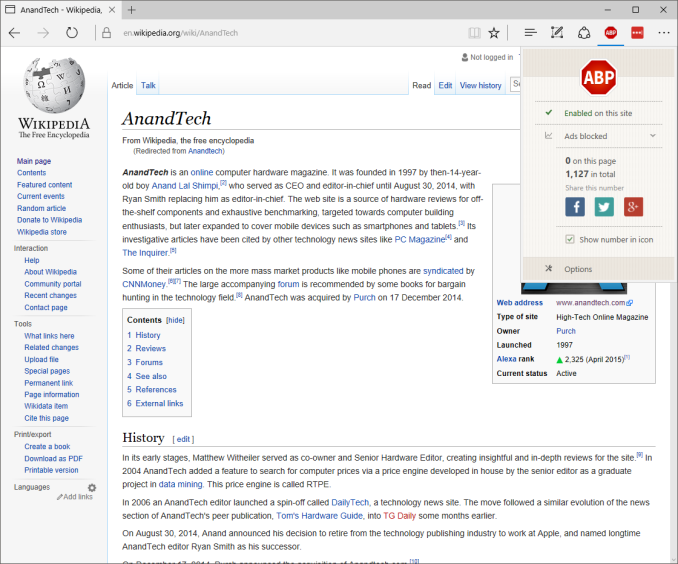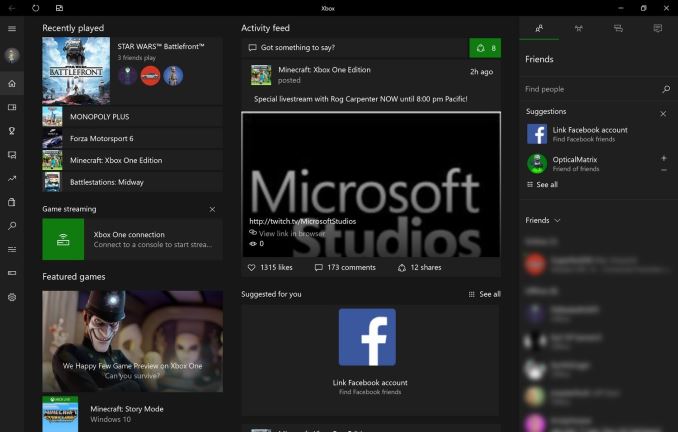Windows 10 Anniversary Update: The Road To Redstone
by Brett Howse on August 2, 2016 8:00 AM EST- Posted in
- Operating Systems
- Microsoft
- Windows 10
Edge and Xbox
Edge Updates
With all of the changes that have come with the Anniversary Update, none have been more impactful or more necessary than the updates to Edge. When Edge came along, it offered some much needed performance improvements over Internet Explorer, and a goal to keep it up to date more, and improve standards compliance. That has happened, at least somewhat, but not to the extent that I had hoped or expected. We were promised that Edge would be updated through the Windows Store, so updates to Edge would no longer be tied to the operating system, but overall that hasn’t happened yet. Edge has been updated, but it seemed to happen only when there was an OS update. There have been a few changes brought along since release, but all of them have been pretty minor. I’m not necessarily disappointed in the update speed of Edge, but more that we’re still stuck with waiting for the core OS to get a major update in order to get a major update to the browser.
Still, the changes that have come for Edge with the Anniversary Update are very welcome. The biggest update is for extensions.
Internet Explorer had plug-ins, but when Microsoft created Edge, they ditched that model completely. The goal was to use extensions, and the extensions would share much of the same ideas as those in Google Chrome. However, the feature didn’t launch with Windows 10, and we’ve had to wait an entire year for it. With this update, Extensions are now available, and it makes Edge all the better for it.
At the moment, there are only a couple of extensions, but likely more will come over time now that it’s officially available and not just part of the insider program. Popular extensions like Lastpass are available, and they are installed and updated through the Windows Store. To find extensions, there is an Extensions hub in Edge’s settings which will take you to the store where you can see and search for them. The insider preview has shown that these extensions can be pretty much as fully customizable as those in Chrome, and other than a few times where the extensions have had to be reinstalled because of an update (and they were reinstalled automatically) the practice of using them has been great. Even though it’s early days, using Lastpass in Edge is already better than it ever was in Internet Explorer, as an example.
Other than extensions, there are other updates to Edge, but none of them are as highly visible. Instead, it gains support for things like Paste and Go, and the ability to navigate forward and backward by swiping the screen to the side, just like Internet Explorer had in Windows 8.1.
You can also specify what to do with downloads now, and change the default save location. Somehow this wasn’t available at launch, but it is here now. Sites that support it can also do web notifications in Edge, and Windows Hello integration is here too, allowing for sign into supporting websites. But don’t worry – your facial image won’t be sent to the site. Instead it will use a token system which Windows Hello will take care of.
Xbox
The Xbox itself is also getting the Anniversary Update, which will bring Cortana, Universal Windows Apps (UWP), and more to the console, but the big addition on the PC side is the new Play Anywhere initiative.
Microsoft has been updating their gaming platform on the PC continuously, and unlike Edge they have not been waiting for major OS updates to bring these changes. For example, in May, Windows 10 gaming got support for V-Sync control and Adaptive Framerate which was an early criticism of Universal Windows App based games like Rise of the Tomb Raider.
With the new WDDM 2.0, quite a bit has changed, and for a full refresher on this I’d recommend the Windows 10 Review which goes into some nice detail. As a summary though, WDDM 2.0 removes the full-screen capabilities of older games, and the sandbox model of UWP means that apps like FRAPS no longer function. It’s a change from the past, and people love the past, but with support now for variable frame rates and V-Sync, the compositing in Windows 10 is the best compromise for a tear-free gaming experience.
The big news on the Xbox side though is that Microsoft has created the Xbox Play Anywhere program. Games that are part of this program will offer both a version on the Xbox One as well as the Windows Store. You can buy the game on either device, and you get the copy on the other. Saved games will sync through the cloud to all devices. While the Xbox One has not been as successful as the Playstation 4, Microsoft has made a smart play by leveraging its other strengths, including PC gaming. Although this will require developer support, Microsoft Studios will be supporting it on all of the games they showed on-stage at E3 this year.
I still think they have some work to do in order to compete against the likes of Steam and Origin though, including the ability to backup games and more. One change that has helped though is that you can now specify which drive to install a game on. Considering games can now easily be 50 GB or more, having that default to the C: drive as it was at launch can be a big problem when you have a smaller SSD as your boot drive. You can now specify where to install the game when you choose to download it.












194 Comments
View All Comments
Penti - Tuesday, August 2, 2016 - link
Centennial is still Win32.Gigaplex - Wednesday, August 3, 2016 - link
UWP is still based on top of Win32 as well.Penti - Wednesday, August 3, 2016 - link
Yeah in large parts, any how Centennial is still using the Win32 VS CRT and all and not Windows Runtime with it's own C++ runtime and framework aka UWP/UWA/Store-app/Modern/Metro/WinRT. As the binaries aren't converted but rather packed into an AppX package. Nothing would work without Win32. You can't even use Windows Runtime to build a Windows Runtime (UWP) app as the development tools won't move to it.API's (some of them) previously only available to Store apps have been made available to Windows/Win32 applications like the inking API so I don't think freezing out Win32 apps by moving new features to WinRT/UWP and to UWP apps only would work or be desirable either. Would only cause fragmentation and vendors would start to replace deprecated or stalled API's with their own stuff which might just make it more difficult to develop for the platform with more stuff you need to support, but probably not as difficult as porting to UWP but still frustrate users and developers.
Achaios - Tuesday, August 2, 2016 - link
Still on windows 7 for my main PC. My old laptop still runs Windows XP.Can't see myself ever upgrading to Windows 10, except when a DX11 game absolutely requires Windows 10 (and DX 11) to make 60 FPS. Even so, I'd return back to the Windows 7 partition after gaming on Windows 10.
Michael Bay - Tuesday, August 2, 2016 - link
I can kinda sorta understand this 7 attachment, but why would you need the fossil?SteelRing - Tuesday, August 2, 2016 - link
There is nothing I need to do that cant be done in Win7, or even WinXP for that matter. Not having that b1tch Cortana in the background spying on you the whole time is a huge relief.smilingcrow - Tuesday, August 2, 2016 - link
XP? Yikes, you can keep that 32 bit over-rated POS and yes there was a 64 bit version which was hardly supported.Achaios - Wednesday, August 3, 2016 - link
My 2003 laptop can't run anything else. Specs below:CPU: Intel Pentium 4@3.06 GHz with HT (1 core two threads)- GPU: NVIDIA Geforce4 460 Go AGP 64 MB DDR RAM - MOBO: Intel 845 PE chipset based - RAM: 2GB DDR RAM@333 MHz -
http://i.imgur.com/Y9oQ6xW.jpg?1
This laptop is all I need to work. It can run Firefox with Ad Blocker, MS Office, and GOM Player and it comes with a 16 inch screen too.
BrokenCrayons - Thursday, August 4, 2016 - link
Your reasoning is perfectly sensible. If your laptop works for you with its given OS and hardware, then you should continue to use it in a way that suits your needs.The point of computer technology from its inception was to assist people in accomplishing tasks more efficiently. To that end, the computer should kowtow to the needs of the person using it by fitting a variety of requirements for mobility, interface, and functionality. I think we've lost sight of a lot of that since the industry has grown in size and gained something of a life of its own. Windows 10 seems something of an outgrowth of computers being mistreated as devices that serves the company making the software they runs rather than supporting the needs of the end user. In the end, Windows 10's master is Microsoft rather than the system owner. The justifications Microsoft will offer are numerous (telemetry gathering, system security, ease of use, following the trend of closed-system modern phones, etc) and other tech companies are just as guilty of lacing services they offer with self-serving capabilities (thanks for being the industry leader on that one Google/Alphabet) that simply don't benefit the end user. What you end up with is a mutually-destructive relationship where end users aren't happy and companies offer polarizing, unsatisfactory products in an attempt to incorporate their own needs into things that are supposed to be all about the customers they serve.
sadsteve - Tuesday, August 2, 2016 - link
Well, I was borderline with my install of Windows 10 but there are just too many negatives vs positives with this release so I regressed my system back to Windows 8.1. I"ll stick with 8.1 till end of support. I just want to operate my machine my way, not Microsoft's way.I did like the idea of the Linux subsystem but that would have been the only plus. As it is, I can continue using MSYS2 for my 'Bash'ing on my Windows box.
And speaking of Bash, I've had Mint Linux on my Vista era laptop for ~9 months and it seems to do everything I need for my daily computing needs (no gaming or Photoshop are done on the laptop). There's even a device driver from Brothers for my multifunction printer.